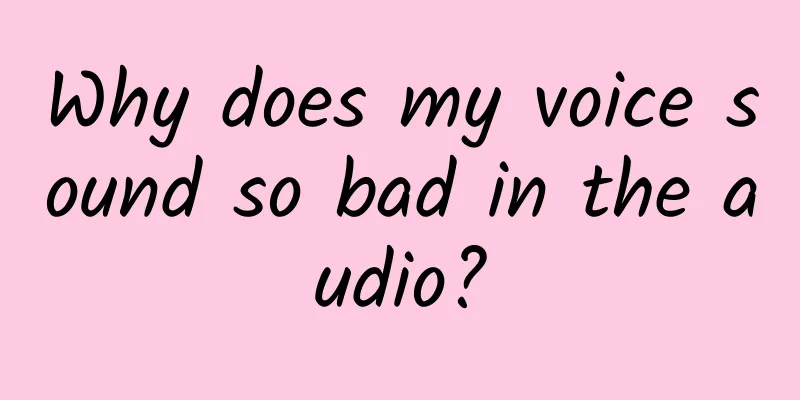Why does my voice sound so bad in the audio?

|
Since the introduction of voice services on social software, more and more people have become accustomed to communicating directly by voice. Compared with text, voice can indeed add a different auditory experience on the basis of the original visual experience. But I don’t know if you’ve ever had this experience: every time you click on your own voice, goose bumps fall all over your body! Are you embarrassed to listen to your own voice? To be honest, I'm not shy. That voice is really "hard to describe". Is my voice really like this? ! I believe many of you have this question: Why does my WeChat voice sound weird? But other people's voices don't seem to be that different? What's going on? (Copyrighted stock image, no permission to reprint) Where does the sound come from? To understand this question, we first need to know how sound is produced. In this world, all sounds are produced by vibration. For example, the reason why the guzheng makes a sound is because the vibration of the strings drives the surrounding air, and the two together produce beautiful sounds. The sound of people speaking is produced by the vibration of the vocal cords. The vocal cords are two elastic membranes located in the middle of the larynx. There is a gap between the two vocal cords, called the glottis. The contraction of the muscles around the larynx can relax the vocal cords (thickening) or tighten (thinning), and can also open or close the glottis. The exhaled air flows through the glottis to make the vocal cords vibrate and produce sound. Controlling the changes in the tightness of the vocal cords can make people produce different pitches of sound. Changes in the vocal cords during exhalation and inhalation (Copyrighted stock image, no permission to reprint) Where does the sound go? So how do people perceive sound? The basic process of hearing sound is roughly three steps: 1. Sound from the outside world causes the eardrum to vibrate 2. The signal generated by the vibration is transmitted to the auditory nerve through the ossicles and other tissues 3. The auditory nerve transmits this signal to the brain, and people can hear the sound. Sound is transmitted in the form of sound waves, but this transmission requires the help of a medium. Solids, liquids, and gases can all be used as media for transmitting sound. Generally speaking, sound propagates fastest in solids, followed by liquids, and slowest in gases. Depending on the different sound transmission media, auditory conduction can be divided into two types: air conduction and bone conduction. In daily life, sound is mainly transmitted by air conduction. Air conduction is the transmission of sound through the air. In this form of transmission, the energy of the sound will be greatly reduced during the transmission process. Bone conduction, on the other hand, transmits sound to the inner ear through the skull and jawbone. Compared with air conduction, bone conduction can better ensure the original timbre and quality of the sound. Imagine that when you are eating cookies, you may feel a loud chewing sound, but people around you may feel it is very slight. In addition to the fact that the closure of the mouth will hinder the propagation of sound to a certain extent, this is also related to the different degrees of attenuation of sound energy by skull transmission and air transmission. It is precisely because air reduces the energy of sound that wearing headphones for a long time is harmful to hearing. Sound generally enters the human ear through air conduction. In this process, the high-frequency part of the sound has been partially absorbed by the air, and its own energy has been weakened, so it will not cause too much damage to the ear. But wearing headphones is different, especially in-ear headphones. The sound source is very close to the inner ear, and the sound wave conduction range is very small and concentrated. The sound pressure will be directly transmitted to the inner ear and concentrated on the eardrum, leaving no room for buffering. Wearing headphones for a long time will not only cause auditory fatigue, but also lead to problems such as hearing loss. Why the sound becomes "strange" When we speak, the sound is transmitted in the above two ways. They are transmitted to the ears through air vibrations, and they are transmitted directly to the inner ear through the mouth, teeth, gums, upper and lower jaws, etc. The sound recorded by electronic devices is first converted into electrical signals and recorded, then restored through the "electric-to-acoustic" conversion system, and finally released from the speaker and transmitted directly to the ear through the air. Compared to hearing the sound of your own speech, it lacks the pathway of being transmitted to the inner ear through the bones, so it sounds different from the sound you usually hear. At the same time, in the sound, the sound with longer wavelength, which is the so-called bass, will be easier to pass through the body tissue to reach the ear. The sound of our own speech is mostly a mixture of the two conductions, so the sound we hear ourselves is generally low and magnetic. This is why the sound we hear ourselves is generally more pleasant to hear. (Copyrighted stock image, no permission to reprint) So which of these two voices is your true timbre? In fact, both voices are real, just from different angles. Generally speaking, there is not much difference between your own voice in social software and the voice heard by others. It is just because you are used to the mixed voice of the two for a long time that you feel that this is obviously your own voice, but it is so strange. If you have any questions about sound, please feel free to leave a message in the comment section to tell Pang Ke ~ Pang Ke will definitely actively give you a scientific explanation ~ Pang Ke would like to say one more thing: do not wear headphones for too long, and pay attention to protecting your hearing health! Creative team: China Science and Technology Museum New Media Team Review expert: Yuan Xiandao, deputy chief physician of the Department of Otolaryngology, Beijing Anzhen Hospital, Capital Medical University |
Recommend
Facebook shut down its artificial intelligence system overnight. Has AI really surpassed human cognition?
With the rapid development of artificial intellig...
(Hanwen - Short Video Postgraduate) One person learns to make a popular short video account through one course
(Hanwen - Short Video Postgraduate) One person le...
In-depth reveal of the search promotion ranking mechanism!
Yesterday a classmate asked me: "Why is the ...
5 ways to express your creative advertising skills!
In 2014, Tim Collins published " 100 ways to...
Can't quit smoking? Going cold turkey actually works
This is the 4712th article of Da Yi Xiao Hu Cold ...
How to build a refined user operation system for the community?
Community operation is actually user operation , ...
Tragedy repeats itself: Why do video content service providers always lose money instead of making any profit?
After the domestic video website company Youku Tu...
Private domain marketing plan for the medical beauty industry!
In this age where looks matter, appearance anxiet...
Can you buy the DIY consoles from e-commerce companies at low prices? The profits are staggering
September to October every year is the peak period...
Community operation: ten active cases of refined community operation
“Any social network operation that does not obser...
25 "Empty-handed" APP promotion methods, you deserve it
Due to various reasons, our company is not like m...
CES2015: Can't wait, Apple accessory manufacturers have already displayed new products
Before the opening of CES 2015, Griffin, a well-k...
NASA waited 11 years for the observation, but was forced to stop by a broken water pipe
We have seen many shocking images of the sun, suc...
"How to get more than 10,000 followers in 15 days" Short video account follower growth course
Course Contents: 1. How to create a profitable ac...
2017 Latest APP Listing Guide for Each App Store
The current domestic traffic is becoming increasi...









